A philodendron is a common indoor plant recognized for its resilience and simplicity of maintenance.
However, that doesn’t imply they’re immune to plant illnesses; they’re exactly like any other indoor plant.
Similarly, being a huge admirer of Philodendron, I can tell that leaf spot disease is one of the most common diseases that affect the plant.
In general, overwatering, excessive sunlight, bacterial and fungal diseases, and pest infestation are the most common causes of brown spots on Philodendron leaves. Brown spots on leaves can also be caused by excessive fertilizing and low humidity.

Even though leaf spot illness is curable, detecting the symptoms is critical, and catching them is essential for your plant.
This article will cover all you need to know about Philodendron Brown Spots, including Causes, Solutions, and Prevention.
Table of Contents Show
Do Brown Spots on Leaves Indicate that the Plant is Dying?
Underwatering, overwatering, or a lack of humidity are the causes of brown spots on the margins and tips of your Philodendron leaves.
Similarly, a fungal or bacterial disease is also frequently indicated by water-soaked black and brown patches on plant leaves and stems.
Brown spots make plants weaker by interfering with photosynthesis.
It does not necessarily indicate that the plant is dying; however, it should be addressed seriously if the plant begins to lose leaves.
However, if the Philodendron is properly taken care of after such brown spots, it might lead to the plant’s death.
Brown Spots on Philodendron Leaves (Causes & Solutions)
A variety of factors can cause brown spots on philodendron leaves. Philodendrons have certain water and light requirements, and if the plant appears sickly, it’s likely due to a failure to meet one of these criteria.
Let’s look at various factors causing brown spots on your luscious leaves of Philodendron.
| Causes | Solutions |
|---|---|
| Excess Sunlight | Keep your Philodendron in the shadow of your other large plants if you have them. |
| Overwatering | You might submerge your plant container in a tub of water. |
| Root Rot | The best solution for root rot is replanting the Philodendron into a new pot |
| Fertilizer Issues | You can replace liquid fertilizers with slow-release pellets. |
| Humidity | Misting the plant’s leaves with filtered or distilled water. |
| Pests | Insecticidal soaps, neem oil, horticultural oils, and, pesticides. |
| Diseases | Removing dead leaves and weeds can also help prevent some fungal diseases. |
| Lack of Air Circulation | Generate air pockets throughout the plant |
1. Excessive Sunlight
Philodendron is a tropical plant, and in a tropical setting, they are protected from direct sunlight by large plants. As a result, they always do well in a dim light environment.
However, if you’ve picked a location for your Philodendron that receives direct sunlight, the leaves will turn yellow and brown blotches will appear over time.
Brownish, burned areas on the foliage, brown tips on the leaves, or even light, yellowed leaves are all signs of scorching or burning in Philodendron.

In addition, a mix of all three will be seen in more severe situations.
Note: The sun’s intensity in the west-south facing window is significantly high, which might cause brown spots on the leaves.
Solutions
- It is important to place your Philodendron in the right location and setting. For example, keep your Philodendron near an east-facing window.
- Similarly, you may keep your Philodendron in the shadow of your other large plants if you have them.
- Many gardening experts recommend using light-colored mulch to reflect the most light and keep the ground cooler.
- You can also use artificial light for your Philodendron as it can withstand low light conditions as well!
2. Overwatering
Philodendrons require constant moisture in their soil; when the soil is dry, they crave water.
Thus, watering your Philodendron before the soil dries out indicates that you are watering it more frequently.
When you overwater your Philodendron, the water saturates the soil, filling up all of the air spaces between the soil particles with water.
Such action causes anaerobic conditions, in which the plant drowns because it lacks sufficient oxygen to thrive. As a result, it leads to brown spots in the beautiful leaves of your Philodendrons.
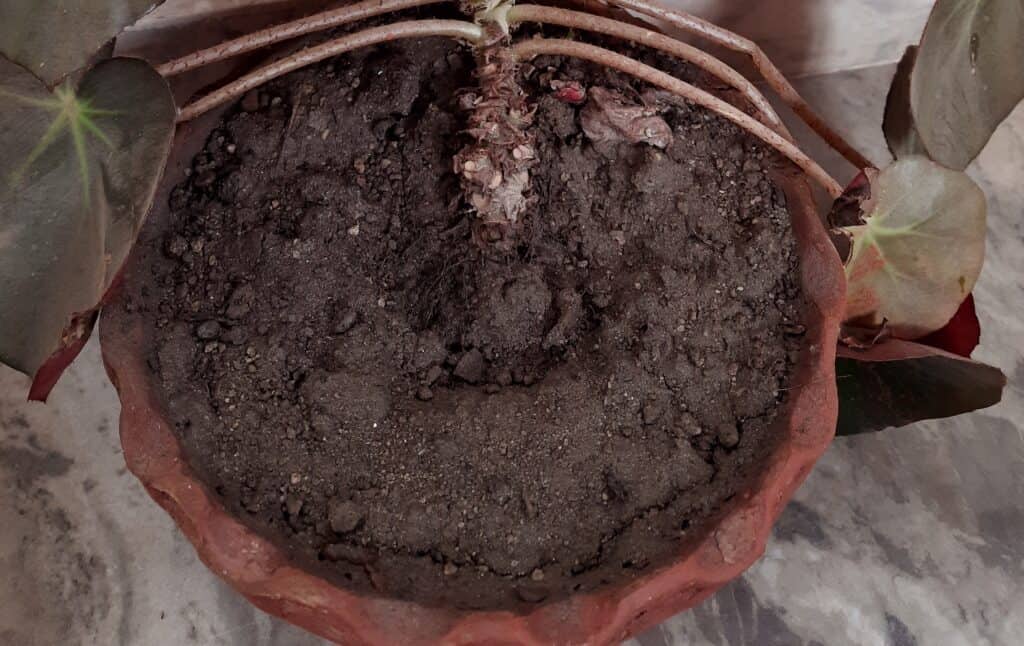
The standard guideline is to check the topsoil by dipping your finger into it for at least an inch. It’s time to water if your finger doesn’t have any soil clinging to it.
A philodendron’s leaf will normally droop if under-watered and dried up. Similarly, when the leaves begin to display brown patches in addition to droopiness, it is a clear symptom of too much water.
Solutions
- It’s better to avoid watering your plants with a hose or by pouring tap water over them in the kitchen sink.
- Alternatively, you might submerge your plant container in a tub of water. The roots of the plants are saturated, and they only take in as much water as they require.
- During vigorous growth in the Spring and Summer, give philodendrons a good soak once a week.
- Similarly, in the winter, water Philodendrons every ten days or so.
- Avoid overhead watering. Water your plant close to the soil.
- Use the right soil mix for your plant that allows for optimum drainage.
- Check the soil’s moisture level using the soil moisture meter.
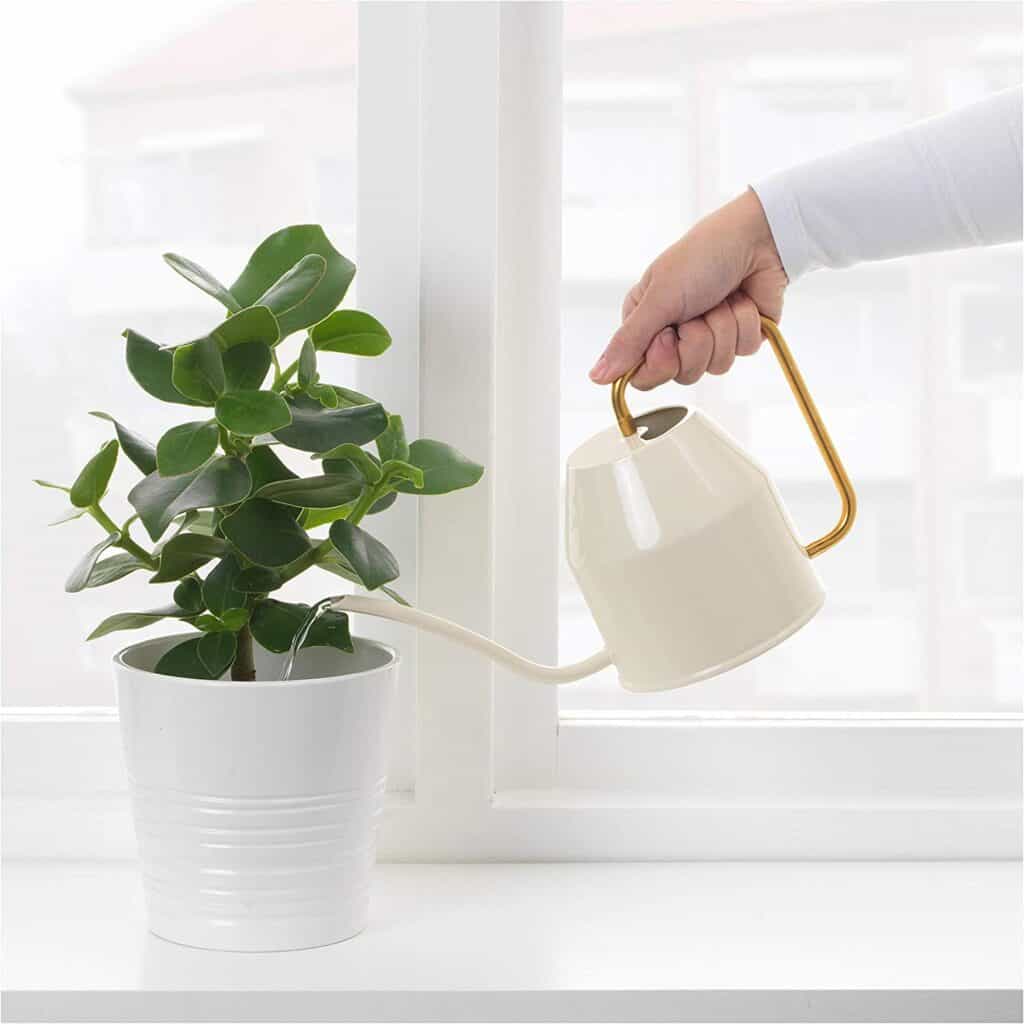
Are you looking for some aesthetic watering cans? Click here to find 10 Cute Mini Watering Cans for Indoor Plants!
3. Stem and Root Rot
Philodendrons sitting in overly wet or saturated soil for an extended time are prone to root rot.
If your Philodendron’s leaves are striped with dark spots despite receiving adequate light and water, it’s time to look at the root ball.
Usually, the roots of a healthy philodendron should be sparkling white. Likewise, Philodendron roots tend to be crowded, and the plant also produces aerial roots.
However, on the other hand, brown, mushy roots indicate root rot and are the primary cause of the increasing number of brown patches on the leaves.
Similarly, even on the stem, various spots can appear, indicating stem rot. The dots might be gray, brown, black, or even bright red in appearance.
Such fungi frequently cause fibrous root tips to rot. Wilting, dieback and a lack of vitality are frequent signs of wilting.
Solutions
- Clean the roots gently under running water and remove all brown, mushy roots with a sharp pair of scissors before replanting.
- Secondly, just above the damaged region, trim the healthy root.
- Likewise, replant the Philodendron as soon as possible.
- To avoid spreading fungal spores to other plants or soil, sanitize the scissors after pruning all roots with a solution of one part bleach to three parts water.
- Treat the potting mix with fungicide or solarization.
Note: The best solution for root rot is replanting the Philodendron into a new pot. Read the article to get the detail information; How to Repot a Philodendron?
Terracotta pots are ideal because they are porous and absorb excess moisture from the soil.
In the long term, it might avoid root damage caused by overwatering, as well as brown stains on the leaves.
4. Excessive Fertilization
It’s possible that brown spots and speckling on leaves are caused by an improper pH and a lack of, or overdose of, specific nutrients.
Excess fertilizer residue in the soil might harm roots and cause spotting signs.
They leave dark blemishes on the luscious leaves of Philodendron. Similarly, too many liquid fertilizers might also have a similar effect.
On the other hand, the deficiency of calcium and magnesium causes yellow spots on leaves which ultimately turn brown.
Overfertilization leads the leaves of your Philodendrons to have brown leaf tips and margins. Similarly, it also causes yellowing and wilting of lower leaves.
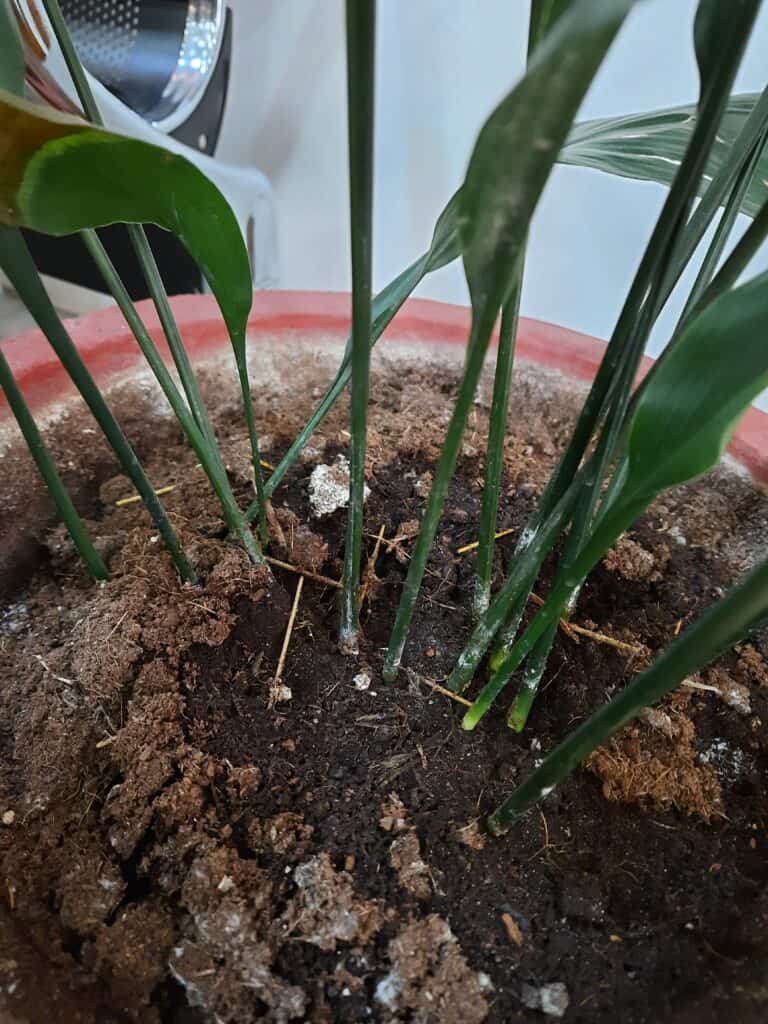
Solutions
- You can replace liquid fertilizers with slow-release pellets.
- Similarly, You should prune brown and burned leaves.
- Next, remove one or two inches of soil from the top and replace it with new soil.
- Remove any visible fertilizer from the plant and soil, and allow water to run through the roots to drain the fertilizer away.
- Philodendrons should be fertilized once a month, from spring through summer. Likewise, fertilize once every six to eight weeks during the fall and winter.
- Use chemical fertilizer such as balanced liquid foliage boosting, all-purpose liquid fertilizer, or balanced NPK ratio 20-20-20.
- If your Philodendron still doesn’t seem to be recovering, repot it.
- In addition, fertilize the plant only once it has fully recovered and appears to be in good condition.
5. Low Humidity
As Philodendrons are tropical plants, they demand humid conditions, which are difficult to achieve indoors.
Your plant will begin to show indications of stress if the humidity levels are too low because as the plant’s transpiration rate rises, it strains to absorb adequate nutrients.
Furthermore, dust accumulation on the leaves may make it more difficult for them to get moisture in the environment.
Solutions
- Misting the plant’s leaves with filtered or distilled water is one of the simplest methods to add at least a little humidity to its surroundings.
- It would be best to place plants in rooms with higher humidity levels, such as the kitchen, bathroom, and laundry room.
- A humidifier is another best and easy method to increase humidity to better plants and humans.
- Put the plants in a pebble tray.
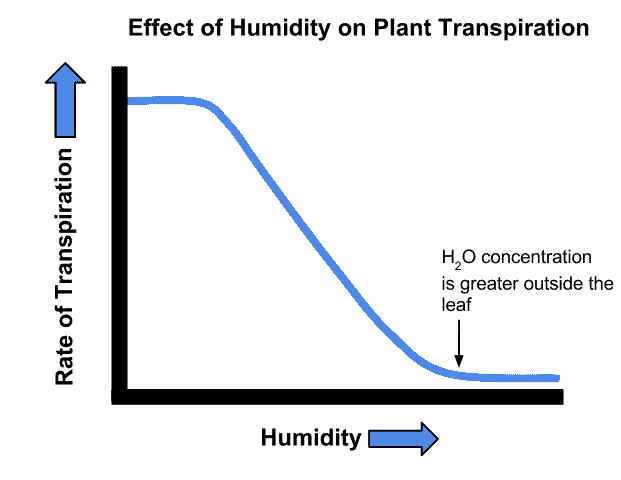
Here is a step-by-step guide to making your pebble tray:
- First, fill your tray halfway with stones, about 2-3 inches deep. Then, spread the stones widely to create a smooth and level surface.
- Similarly, fill the tray halfway with water, leaving a half-inch of dry pebbles on top. Again, you don’t want the water in the pot to reach the drainage hole, so your plant will rest on this dry layer of stones.
- In the middle of the pebble tray, place your potted plant. Then, return your plant to its customary location in your house, together with its new pebble tray.
Note: To avoid attracting insects, be sure to rinse your pebbles and refresh the water in your new pebble tray regularly. Rinsing will help flush out any fertilizer residue accumulated in the tray.

6. Infestation of Pests
Although philodendrons are typically hardy plants that aren’t susceptible to illnesses or pests, some disorders might infect the plant.
Aphids, mealybugs, scales, and spider mites are some of the most frequent pests that affect philodendrons.
Aphids are usually found on the undersides of leaves, where they produce a sticky material that collects dirt and debris, resulting in brown blotches on the leaves.
Similarly, Spider mites leave feeding marks on the leaves of Philodendron, which appear as little light-colored spots. The leaves become brown, dry out, and fall off over time.
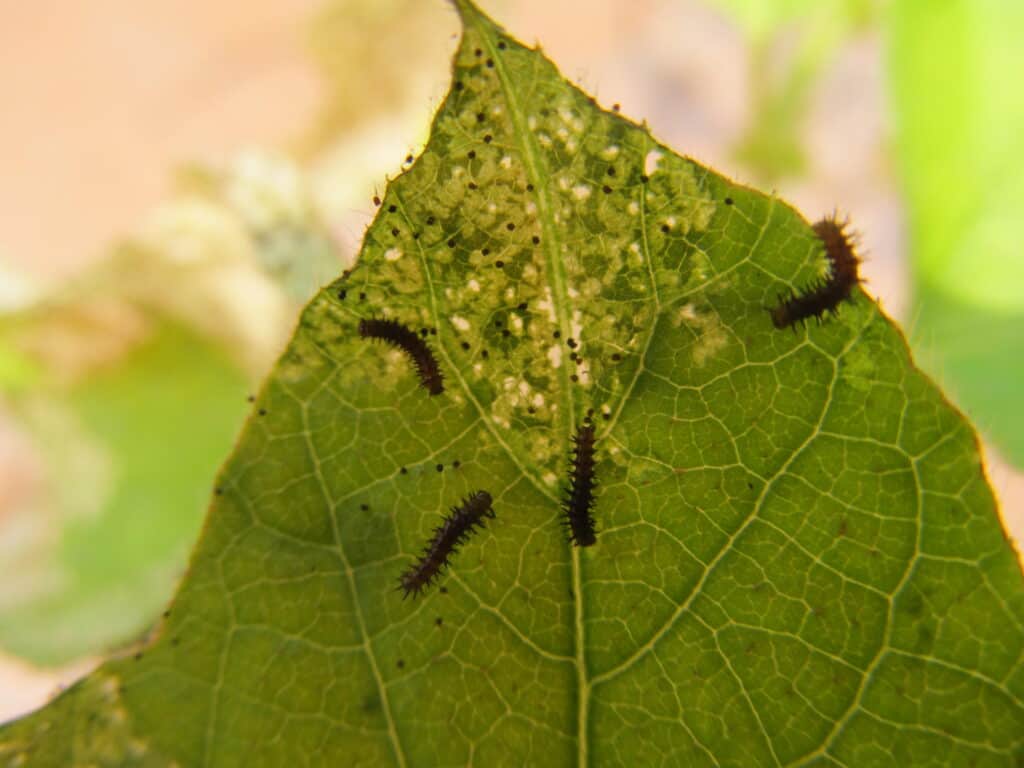
Solutions
- Pruning highly affected leaves or portions of the plant is a quick control approach.
- Insecticidal soaps, neem oil, horticultural oils, and, as the last option, pesticides can all be used to treat and manage a pest infestation.
- When utilizing spray-on treatments, coat the leaves and their undersides and continue the process until the infestation has been eradicated.
Preventive Measures
- Check your plants for aphids regularly, paying special attention to plants where you’ve previously discovered aphids.
- Don’t overfeed your plants with fertilizer—aphids like plants with high nitrogen content.
Are the pests being a big problem for your indoor plants? Click here to get the full guide on How to Use Neem Oil on Indoor Plants.
7. Diseases in Philodendron
If the leaves wilt quickly, turn yellow often, or new growth has brown spots, it’s time to investigate the illnesses which affect most philodendrons.
Let’s have a look at the diseases which might invite brown spots on your Philodendron leaves:
Bacterial Leaf Spot
The pathogen Xanthomonas campestris PV causes bacterial leaf spots. Dieffenbachia causes transparent patches on leaf edges to become brown with tan or yellow halos.
Similarly, because bacteria thrive in moist environments, if you overwater your Philodendron, germs can increase in the soils.
The spots are uneven in shape and have non-uniform patterns, and they spread across leaf surfaces randomly.
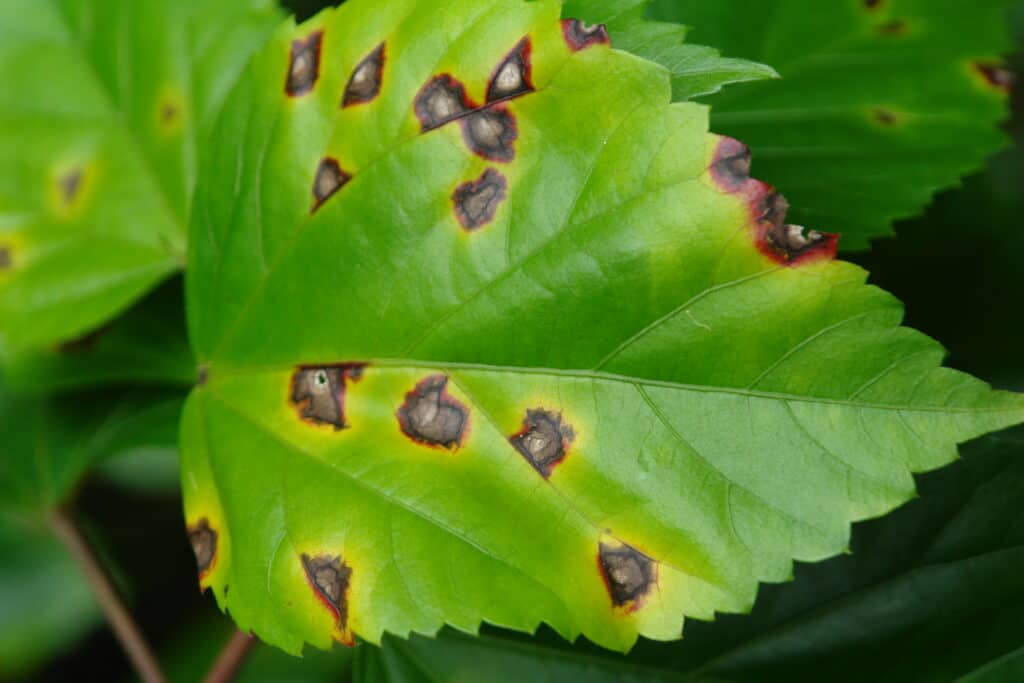
Preventive Measures
- All infected plant material should be removed.
- After removing the affected plant portions, apply copper soap or Bacillus amyloliquefaciens to prevent spreading.
- Low temperatures, crowding plants, and spraying or splashing water on the leaves are all things to avoid.
- Remove any old vegetable trash from the garden and avoid planting new crops where host plants formerly thrived.
- Avoid overhead watering. Watering from above should be avoided. It will keep moisture from sitting on your Philodendron’s leaves.
Note: There is no chemical treatment for plant infected with Bacterial Leaf Spot.
Anthracnose
Anthracnose is a fungus that affects many plants in warm, humid environments.
The causative fungus (Colletotrichum or Gloeosporium) generates spores in acervuli, small, hollow, saucer-shaped fruiting structures.
Sunken patches or lesions (blight) of various colors appear on leaves and stems, and some illnesses cause cankers to grow on twigs and branches.
The leaf tips change color from yellow to tan to dark brown. The browning might go all the way around the leaf.
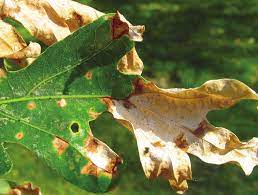
Preventive Measures
- Instead of using an overhead sprinkler, use a drip sprinkler to water your plants. When the plants are damp, avoid touching them.
- Plant your plants on soil that drains effectively. You may also use compost to help plants avoid illness by enriching the soil.
- Use a Neem oil spray to eliminate insect eggs, larvae, and adults, preventing fungal attacks on plants.
- Apply Liquid copper sprays and sulfur powders weekly when foliage begins to grow during spring and continues throughout the growing season to prevent the disease.
Note: According to several studies, once symptoms develop, Anacthrose can’t be effectively controlled. Some pesticides are available to help prevent anthracnose infections, although they don’t always work.
Fungal Leaf Spot Disease
According to the research, the Dactylaria leaf spot is caused by the fungus Dactylaria humicola, which is more common in vining philodendrons. The disease seems to be prevalent in hot, rainy summers.
The disease first manifests itself in the diseased young leaves. Before turning brown, the 1/8-inch-wide lesions have yellowish-green edges.
The lesions have a protrusion in the middle.
However, the study also revealed other Philodendron species, such as Philodendron hastatum, Philodendron selloum, Philodendron Florida, Philodendron laciniatum, Philodendron miduhoi, and Philodendron Red Imperial were found to be susceptible to the pathogen.

Spots on the leaves are the most common indication of a leaf spot infection. Similarly, spots are usually brownish, although they can also be tan or black. Blotches can also occur when the spots merge or grow over time.
Solutions
- Fungicides such as Benlate, Captan, Daconil, Dithane, and Mertect are effective against the pathogen.
- It would be best if you sprayed your plant’s leaves with a dilute solution of bicarbonate of soda (baking soda) using ½ teaspoon per gallon (2.5 mL. per 4 L.) of water.
Preventive Measures
- Isolate your Philodendron pot from other plants.
- Prune out the infected leaves.
- Stop misting your plant.
- Removing dead leaves and weeds can also help prevent some fungal diseases.
8. Lack of Air Circulation
Insufficient supply of air circulation around your Philodendron will invite leaf spot diseases that will harm your plant.
Air circulation is vital for your plant because it aids in evaporating surface moisture. While you don’t want to aim a fan towards your plant, you may set one in the room with it to ensure adequate air circulation.
People frequently believe that sprinkling your plants would increase the humidity surrounding them, but this water lingers on the leaves, providing a suitable breeding ground for germs.
Solutions
- When watering your plant, gently probe the soil around the roots with a chopstick to generate air pockets throughout the plant.
- Make sure your plant is in an open environment with enough ventilation to ensure optimum air circulation around it.
Note: Pocketing will allow your Philodendron’s roots to obtain the oxygen they need to flourish while preventing them from being clogged with water and decaying.
Additional Tips to Prevent Brown Spots in Philodendron
Here are some simple strategies to keep your philodendrons in good shape. By following them, you may prevent brown spots from appearing on your philodendron plants’ stunning foliage.
- Feed your philodendrons some water first thing in the morning, so they have the rest of the day to replenish and absorb sunlight to begin photosynthesis.
- Similarly, you should avoid watering your Philodendron from above. Instead, you can pour the water on a saucer and let the plant absorb the water from below.
- Philodendron prefers rainwater or distilled water. However, if you use tap water, make sure to let it rest in the container for at least a day with the lid open.
- Leaves should always be misted and wiped with a paper napkin or a towel. The leaves will benefit from the humidity, and washing them clean will remove the dust, which will keep dust mites at bay.
- For constant growth, rotate your pot once a month. Leaves constantly face the direction of light, and vines always strive for it. As a result, turning the plant ensures that it grows from all sides.
- Similarly, pruning your philodendrons should be done regularly. Pruning will make those vines or climbers bushier by creating new growth, increasing the plant’s defenses against pests.
- If you’re using a liquid fertilizer, dilute it with water before giving it to the plants to prevent generating a burn and brown blotches.

Conclusion
Philodendron is a vigorous and robust plant, making it more adaptable to any environment. Your Philodendron, like many other plants, may, however, suffer from a variety of problems.
It is critical to monitor the health of your plants every week to ensure that any infections are caught early and that your plant receives the correct light, air circulation, and watering operations to stay healthy.
Follow the tips above to ensure that your Philodendron grows robust and healthy.
